#hemp seed oil uses
Explore tagged Tumblr posts
Text
Superfoods you should incorporate in your diet:
Superfoods are nutrient-dense foods that are considered beneficial for your health due to their high concentration of vitamins, minerals, antioxidants, and other beneficial compounds.
Combine these superfoods with a variety of other whole foods to ensure you're getting a wide range of nutrients. Also, be mindful of portion sizes and any individual dietary restrictions or allergies you may have.
Berries: Blueberries, strawberries, raspberries, and other berries are rich in antioxidants, fiber, and vitamins.
Leafy greens: Spinach, kale, Swiss chard, and other leafy greens are packed with vitamins, minerals, and fiber. They are low in calories and provide important nutrients like vitamin K, vitamin C, and folate.
Cruciferous vegetables: Broccoli, cauliflower, Brussels sprouts, and cabbage are part of the cruciferous vegetable family. They contain compounds that may help reduce the risk of certain cancers.
Nuts and seeds: Almonds, walnuts, chia seeds, flaxseeds, and hemp seeds are excellent sources of healthy fats, protein, fiber, and various vitamins and minerals.
Fish: Fatty fish like salmon, sardines, and mackerel are rich in omega-3 fatty acids, which are beneficial for heart health and brain function.
Whole grains: Quinoa, brown rice, oats, and whole wheat are examples of whole grains that provide fiber, vitamins, and minerals.
Legumes: Beans, lentils, chickpeas, and other legumes are high in fiber, protein, and various nutrients. They are also a good source of plant-based protein.
Turmeric: This spice contains curcumin, a compound with potent anti-inflammatory and antioxidant properties.
Green tea: Green tea is rich in antioxidants called catechins and is believed to have various health benefits, including improved brain function and a lower risk of certain diseases.
Dark chocolate: Dark chocolate with a high cocoa content (70% or higher) is a source of antioxidants and may have positive effects on heart health and mood.
Avocado: Avocados are rich in healthy fats, fiber, and various vitamins and minerals. They also provide a good source of potassium.
Greek yogurt: Greek yogurt is a protein-rich food that also contains beneficial probiotics, calcium, and vitamin B12.
Sweet potatoes: Sweet potatoes are packed with vitamins, minerals, and fiber. They are an excellent source of beta-carotene, which is converted into vitamin A in the body.
Garlic: Garlic contains sulfur compounds that have been associated with potential health benefits, including immune support and cardiovascular health.
Ginger: Ginger has anti-inflammatory properties and is commonly used to aid digestion and relieve nausea.
Seaweed: Seaweed, such as nori, kelp, and spirulina, is a rich source of minerals like iodine, as well as antioxidants and omega-3 fatty acids.
Pomegranate: Pomegranates are packed with antioxidants and are believed to have anti-inflammatory properties. They are also a good source of vitamin C and fiber.
Cacao: Raw cacao is the purest form of chocolate and is rich in antioxidants, flavonoids, and minerals. It can be enjoyed as nibs, powder, or in dark chocolate form.
Quinoa: Quinoa is a gluten-free grain that provides a complete source of protein, along with fiber, vitamins, and minerals.
Extra virgin olive oil: Olive oil is a healthy fat option, particularly extra virgin olive oil, which is high in monounsaturated fats and antioxidants.
Chia seeds: Chia seeds are a great source of fiber, omega-3 fatty acids, and antioxidants. They can be added to smoothies, yogurt, or used as an egg substitute in recipes.
Beets: Beets are rich in antioxidants and are known for their vibrant color. They also contain nitrates, which have been shown to have beneficial effects on blood pressure and exercise performance.
Matcha: Matcha is a powdered form of green tea and is known for its high concentration of antioxidants. It provides a calm energy boost and can be enjoyed as a tea or added to smoothies and baked goods.
Algae: Algae, such as spirulina and chlorella, are nutrient-dense foods that are rich in protein, vitamins, minerals, and antioxidants. They are often consumed in powdered or supplement form.
Fermented foods: Fermented foods like sauerkraut, kimchi, kefir, and kombucha are rich in beneficial probiotics that support gut health and digestion.
Maca: Maca is a root vegetable native to the Andes and is often consumed in powdered form. It is known for its potential hormone-balancing properties and is commonly used as an adaptogen.
Goji berries: Goji berries are small red berries that are rich in antioxidants, vitamins, and minerals. They can be enjoyed as a snack or added to smoothies and oatmeal.
Hemp seeds: Hemp seeds are a great source of plant-based protein, healthy fats, and minerals like magnesium and iron. They can be sprinkled on salads, yogurt, or blended into smoothies.
Moringa: Moringa is a nutrient-dense plant that is rich in vitamins, minerals, and antioxidants. It is often consumed as a powder or used in tea.
Mushrooms: Certain mushrooms, such as shiitake, reishi, and maitake, have immune-boosting properties and are rich in antioxidants. They can be cooked and added to various dishes.
#health tips#healthy lifestyle#health and wellness#nutrients#healthy life tips#healthy life hacks#healthy diet#level up journey#high value mindset#health is wealth#levelupjourney#glow up tips#glow up#nutrition#healthy living
2K notes
·
View notes
Text
My lovely friends, this is a friendly evidence-based post pertaining to the risk reduction of a few well-known health effects of 4n4 and mia. Including: Amenorrhea (loss of regular menstrual period), anaemia, digestive upset, dehydration, electrolyte imbalance, general well-being, and osteoporosis. It is quite a long post, but please let me know if there’s any other information you would like me to cover. 💕
🪐 Vitamins and Supplements:
• A-Z Multivitamin. Is beneficial for supplementation. For example, Vitamin C is a vitally important vitamin for the body’s connective tissues, including the maintenance of healthy bones and teeth, cellular formation and maturation, resistance to infection, and an increased ability to heal. Additionally, B12 contributes to an adequately functioning nervous system, bone marrow, and intestinal tract. It also acts to increase metabolism of protein, carbohydrates, and fats. Finally vitamin B2 when combined with Vitamin A promotes good vision and healthy skin, as well as assists in metabolising proteins and fats at a cellular level.
• Calcium and Vitamin D. Seek a preparation which offers 1000mg of calcium and 10-20mcg (400-800 iu) of vitamin D. Vitamin D increases the bodies efficacy during the absorption, retention, and metabolising of calcium. Calcium of course being vital for bone integrity and imperative for the prevention of osteopenia/osteoporosis.
• Iron. An appropriate iron intake will restore the functionality of red blood cells, allowing the proper oxygen transportation around the body, increase focus, energy, athletic performance, and sleep. Having a sufficient iron store will alleviate some commonly experienced symptoms of low iron including fatigue, dizziness, pallor, and shortness of breath. It may also reduce the sensation of cold hands and feet.
• Potassium and Zinc. A lack of zinc impairs the ability to smell and taste. Connecting this impairment to nose blindness. For example, a lack of a sense of smell and taste may impair one’s own ability to detect their own bad breath, BO, and other unpleasant smells that others may be able to detect.
• Omega 3’s - Fish oil, Krill oil, Hemp oil, or Flaxseed oil. Improper dietary intake, or supplementation of omega 3 fatty acids will result in areas of epidermal (skin) dryness, hyperkeratosis, and hyperpigmentation. As well as the formation large scales expose underlying tissue, which are easily infected. The hair becomes sparse, dry, lusterless, and brittle, with a reddish tinge. Furthermore, nails become brittle and dull, tear production reduces, the tears are also significantly less oily leading to increased evaporation contributing to chronically dry, red, and itchy eyes.
If oil supplements are scary for you to intake due to calorie fears (there is only approx 25 calories in 2 average fish oil capsules). There are dietary sources of omega 3 that are relatively low calorie including chia seeds, edamame, and seaweed. However they provide little amounts in comparison to supplementation or traditional dietary sources such as fish, avocado, oils etc.
However this should also be considered when deciding whether to supplement omega 3’s - they stimulate the secretion of leptin, a hormone that decreases appetite and promotes the burning of fat. Through the enabling of conversion of dietary fats into body cells for burning as fuel.
🍄 Dietary Intake
•Bone broth (or vegetable broth if meat is not apart of your diet ☺️) I cannot stress how great bone broth is! Extremely low calorie, but incredibly nutrient-dense. It also acts to decrease the inflammation within the gut that many of us will experience due to our dietary habits. Including conditions such as constipation, gastroparesis, liver disease, bloating, abdominal pain, and stomach ulceration.
Bone broth also contains large amounts of protein, collagen, iron, vitamins A and K, fatty acids, selenium, zinc, and manganese. Protein being the most satiating macronutrient can decrease hunger and associated discomfort. Collagen and the variety of micronutrients within the bone broth contributes to joint and bone health. Bone broth will also contribute to hydration.
•Nutrient-dense foods including blueberries l are among the best sources of anthocyanins (antioxidants) that promote brain health and reduce the risk of cognitive decline. Additionally, red tomatoes and red capsicum (Peppers). Tomatoes are the richest source of lycopene, which is a type of carotenoid found in red fruits that has powerful antioxidant effect that may help protect against heart disease and certain types of cancer.
•Fibre is imperative for smooth gastrointestinal function, including regular bowel movements. Fibre is of course typically found in whole fruits and vegetables, beans/lentils, and whole grains. Low calorie fibre sources include: red kidney beans, carrot, and chickpeas. Psyllium, chia seeds are also good sources of fibre. Fibre supplants such as Metamucil may also aid to increase fibre intake. An adequate intake of fibre may reduce the dependence of laxative for bowel movements. Prolonged use of laxatives may create a dependency on them to even have a bowel movement.
🥥 Adequate Hydration
• The best way to ensure adequate hydration is simply by consuming enough water during the day. However, if plain water consumption is difficult, fluid intake will also suffice. Including fluid such as teas, flavoured/enhanced water, diet soft drinks, juices, etc. The optimal fluids to consume in addition to, or instead of simple water to ensure adequate hydration is mineral water, coconut water, or diet electrolyte replacements (Powerade/Gatorade, Pedialyte, Hydralyte). Correct hydration and electrolyte intake will reduce headaches, constipation, and muscle cramps/weakness.
❤️ Reproductive Health
•Amenorrhea is a common experience for those of us with a uterus. However it is imperative to understand that you are more than likely still ovulating despite the lack of a regular menstrual period. Therefore, contraception must still be used. Amenorrhea may be alleviated through dietary supplementation and small changes to the diet to include more micronutrients, but it may not be completely fixed unless there is an increase to body fat percentages.
#fitblr#ed not ed sheeran#ed#edblr#edtwt#ed tmblr#ed bullshit#anorex14#tw ana shit#ana and mia#tw mia#ana e mia#tw ed diet#meanspø#grossp0#fitspiration#notprojustusingthetags#4norexi4#4n4#4n4blr#4norexia
245 notes
·
View notes
Text
Is there any way to reverse grey hair?
Empress, I’m the Indian anon (wine lover like you). We women in South India consume Curry leaves from the curry leaf plant everyday in every dish. It’s impossible to have dish without these leaves. And if you google ‘south indian hairstyles’, you will see us with thick, luxurious hair!
You can get these curry leaves in the form of powder in Amazon. Due to the stressful circumstances in my life, I developped white hair in my thirties. I’ve restarted eating them & slowly I can see my genetic hair colour growing back!
I’d like to share a recipe that I use. You can buy this powder from amazon. I warm equal quantities of flax seeds, pumkin seeds& hemp seeds in a pan (to remove humidity) & grind it in a coffee grinder. Mix this with the curry leaf powder & a pinch of salt. Take 2 teaspoons everyday in your curd or porridge or soup or just sprinkle on your sandwich. Results are seen over a two month period. (Those with allergies, please consult a doctor first!)
(DISCLAIMER): I’m not a doctor! This is my personnal concotion! Apart from the curry leaves, I’ve taken advice from You tubers. Curry leaves contain Folic acid which helps to boost developement of RBC &WBC, also helps increase good gut bacteria.
Also, once a week, massage your scalp with coconut oil 10 minutes before washing your hair. Indian women apply coconut oil everyday but it is to help bear the intense tropical heat as it is very cooling.
====
Thank you so much! What a great testimony and so glad this works for you.
I am on Nutrafol right now and that shit is expensive AF.
29 notes
·
View notes
Note
Homemade Basil Pesto Recipe
Homemade basil pesto is a wonderfully versatile and tasty sauce/spread made from a handful of flavorful ingredients. It comes together in minutes and tastes worlds better than store-bought because it’s so fresh. (Just like with lemon curd, store-bought pesto is nothing like real, FRESHLY made pesto!)
The uses for pesto are virtually endless, and you can use it in recipes like pesto pizza and pesto shrimp. Or use it as pasta sauce, drizzle it over grilled chicken, eggs, or roasted vegetables, spread it on sandwiches or homemade bread, or even swirl into hummus or minestrone soup.
homemade basil pesto
Today’s homemade basil pesto recipe is my absolute favorite. It’s classic, simple, flavorful, and completely fresh. You’ll appreciate how easily it comes together and that it tastes infinitely better than store-bought versions. Homemade pesto can be a dip, sauce, or spread and pairs wonderfully with so many flavors. Bottom line? Pesto is an easy way to instantly elevate any savory dish.
Originating in Genoa, Italy, pesto was traditionally made by crushing the ingredients with a mortar and pestle. Now it’s typically done with the convenience of electric tools like a food processor or blender. You don’t need to cook it at all, unless you want to roast the garlic first.
This Homemade Basil Pesto Is:
Fresh and flavorful
Incredibly versatile
Ready in minutes
Made with just a few ingredients
Easy to customize with what you have on hand
Extra flavorful with roasted garlic
fresh basil
parmesan cheese, roasted garlic, pine nuts, olive oil, lemon, and basil on countertop.
Key Ingredients You Need & Why
Basil: Fresh basil leaves are the base of this pesto recipe. Rinse and pat dry before using.
Pine Nuts: Pine nuts add structure and a light nutty flavor to the pesto. If I’m having trouble finding pine nuts, sometimes I’ll swap them for walnuts, pistachios, or almonds.
Parmesan Cheese: Fresh parmesan cheese adds a little saltiness and helps the pesto stick together. In place of parmesan (aka parmigiano-reggiano), you can use any Italian-style hard cheese, such as pecorino romano, asiago, or grana padano.
Garlic: It goes without saying that garlic adds incredible flavor to homemade pesto. I urge you to try using roasted garlic because the flavor isn’t as harsh as raw garlic. (Here’s how to roast garlic.)
Olive Oil: Olive oil is the main liquid and helps create a creamy, rich consistency.
Lemon Juice: 1 teaspoon of fresh lemon juice brightens everything up and really helps the other flavors shine. Many recipes don’t call for it, but I highly recommend it.
Salt & Pepper: Both add flavor and you can add them to taste.
Make it your own: For a twist, try adding your favorite herbs like cilantro, mint, or parsley; your favorite spices like cayenne, ground ginger, paprika, or crushed red pepper flakes; or add a dash of your favorite hot sauce.
FAQ: What Can I Use Instead of Basil?
When fresh basil isn’t in season, it can be really pricey or even impossible to find. I like to use kale, spinach, or arugula in its place. You can find the kale variation I like to use in this pesto pasta salad recipe.
FAQ: What Can I Use Instead of Pine Nuts?
Pine nuts can be really expensive, not to mention hard to find! Walnuts, pistachios, and almonds are all great 1:1 substitutes and you can’t really detect a flavor difference in the finished pesto.
For nut-free pesto, try pumpkin seeds, hemp seeds, sunflower seeds, or cooked and cooled edamame.
pesto in food processor
Overview: How to Make Homemade Basil Pesto
Basil pesto comes together in a matter of minutes using a food processor or blender; just a few pulses and you’re done. The ingredients blend together rather easily, so if you don’t have a fancy food processor, don’t worry. It will still taste like pesto and it will still be good. (It’s hard to mess this up.)
Blend the basil, pine nuts, cheese, and garlic together in a food processor or blender. Add the olive oil and pulse/process to blend. Scrape down the sides of the blender bowl, then add the lemon juice, salt, and pepper. Pulse this mixture until everything is blended together and relatively smooth. Taste and add more seasoning and any extra herbs/spices if desired.
Can I double or triple the recipe? Yes, you can easily scale up this recipe if your food processor/blender has the room!
spoonful of homemade basil pesto coming out of a jar.
How to Use Homemade Pesto
If you need inspiration, here are MANY ways you can use this basil pesto:
Pesto Tortellini: Use as a sauce over cooked tortellini with parmesan cheese and fresh diced tomatoes.
Shrimp: Try my creamy pesto shrimp for dinner—it’s super quick!
Pizza: Use it in place of pizza sauce on pizza crust; here is my pesto pizza recipe.
Pesto Bruschetta: Bake slices of a fresh baguette in a 400°F (204°C) oven until golden. Top with pesto, parmesan cheese, and diced fresh tomatoes.
Stuffed Peppers: Use pesto in my sausage stuffed peppers recipe instead of the chicken broth. (Same amount—tastes fantastic.)
Focaccia: Skip the herbed olive oil topping on focaccia (step 8) and spread 1/2 cup of pesto all over the dough instead.
Star Bread: Use my star bread recipe and reduce the amount of sugar in the dough to 1 Tablespoon. Spread 1 heaping Tablespoon of pesto onto each of the 3 circles. (3 Tbsp. total.) Top each with a light layer of shredded cheese, herbs, and/or chopped pepperoni.
Pesto Sandwich: Spread pesto on toasted bread, and add your favorite cheese or meat, greens, and tomato.
Pesto Grilled Cheese: Brush 2 slices of thick-cut crusty bread (like artisan bread) with pesto, add provolone or cheddar cheese, butter the outside of the bread, and cook both sides on a griddle or skillet until golden brown.
Swirl in Soup: Swirl a few spoonfuls into a bowl of minestrone soup.
Hummus: Blend 2 Tablespoons of pesto with parmesan garlic hummus.
As a Dip: Use it as a dip for homemade bread, breadsticks, crackers, or pizza pull apart rolls.
As a Spread: Spread it on olive bread or seeded oat bread.
As a Topping: Drizzle over cooked meats, fish, eggs, chicken meatballs, or roasted vegetables.
slices of pesto pizza made with mozzarella cheese and fresh pesto on top.
creamy pesto shrimp
Pesto pizza & creamy pesto shrimp recipes.
FAQ: How Long Does Homemade Pesto Last?
You can store this basil pesto in a jar or sealable container, then tightly seal and refrigerate for up to 1 week or freeze for up to 2–3 months. Let it thaw at room temperature or in the refrigerator.
To prevent your pesto from browning in the fridge, pour a layer of olive oil on top before tightly covering or sealing the pesto.
You could also freeze the fresh pesto in small amounts, in a greased ice cube tray, and then thaw the amount you need for a recipe when you need it, so you don’t have as much leftover to store in the fridge.
spoonful of homemade basil pesto coming out of a jar.
Easy Homemade Pesto Recipe
★
★
★
★
★
4.9 from 20 reviews
Author: Sally
Prep Time: 10 minutes
Cook Time: 0 minutes
Total Time: 10 minutes
Yield: 1 cup
Description
This is how I make classic basil pesto at home. It’s incredibly simple and flavorful and uses only a handful of fresh ingredients.
Ingredients
2 cups (60g) fresh basil leaves*
1/3 cup (48g) pine nuts*
1/3 cup (25g) freshly grated or shredded parmesan cheese
3 small cloves garlic (roasted garlic or fresh)*
1/3 cup (80ml) olive oil
1 teaspoon fresh lemon juice
1/4 teaspoon salt
freshly ground black pepper, to taste
Cook Mode Prevent your screen from going dark
Instructions
Pulse the basil, pine nuts, cheese, and garlic together in a food processor or blender. Scrape down the sides, then add the oil, lemon juice, and salt. Pulse until everything is blended together and relatively smooth. Add a drizzle more olive oil to thin out, if desired. Taste and add pepper (and/or more salt) if desired. I always add a pinch of pepper.
Store pesto in a jar or sealable container, tightly seal, and refrigerate for up to 1 week.
Notes
Storing & Freezing Instructions: You can store this basil pesto in a jar or sealable container, then tightly seal and refrigerate for up to 1 week. To prevent browning, pour a layer of olive oil on top of the pesto before sealing. Freeze the pesto for up to 2–3 months. You can freeze it in greased ice cube trays and thaw small portions at a time. Let it thaw at room temperature or in the refrigerator.
Special Tools (affiliate links): Food Processor or Blender
Basil or Other Greens: Instead of basil, try other greens like spinach, kale, or arugula. No matter which greens you choose, rinse and pat dry before using.
Nuts: If I’m having trouble finding pine nuts, sometimes I’ll swap them for walnuts, pistachios, or almonds. For a nut-free version, try cooked and cooled edamame, pumpkin seeds, hemp seeds, or sunflower seeds.
Parmesan Cheese: In place of fresh parmesan (aka parmigiano-reggiano), you can use any Italian-style hard cheese, such as pecorino romano, asiago, or grana padano.
Garlic: If you don’t have fresh garlic cloves, use 3 teaspoons minced garlic from the jar.
Other Pesto Variations: Try adding your favorite herbs like cilantro, mint, or parsley. Add your favorite spices like cayenne, ground ginger, paprika, or crushed red pepper flakes. Or add a dash of your favorite hot sauce.
I’m only posting this because it actually sounds kind of good
45 notes
·
View notes
Text
Nepal-based startup Shah Hemp Inno-Ventures (SHIV) is a unique social enterprise transforming wild-grown hemp, bamboo and other natural resources into a catalyst for fair employment, economic growth and climate-change mitigation. Guided by a mission to harness local resources for global impact, SHIV also cultivates relationships with local communities to ensure a positive impact and above-standard working conditions for its employees — who essentially turn local ‘weeds’ into everything from hemp bags, backpacks, paper, soaps, hemp seed oil and hempcrete to bamboo mats and furniture. We spoke with Chief Operations Officer Nivedita Bansal to learn more about how the organization combines sustainable farming, waste management, and community empowerment to build a more environmentally sustainable and socially equitable future.

According to Cambridge University researcher Darshill Shah, “Hemp can capture atmospheric carbon twice as effectively as forests while providing carbon-negative biomaterials for architects and designers.” A hectare of hemp can absorb 8-15 tonnes of CO2. In comparison, forests only capture 2-6 tonnes, depending on the type of trees and region.
SHIV’s product line essentially turns waste into products, but how do you manage your own waste?
NB: Our primary business model is in fact based on managing waste: Wild hemp is seen as a nuisance to local farmers and is usually just chopped away and burned. Hemp fibers are fully compostable, making most of the materials we don’t use for manufacturing indeed compost. Our facility is zero waste; and we recycle, upcycle or reuse all the inorganic waste — such as bag straps, zippers, utility attachments and other similar materials utilized during manufacturing. By communicating with local municipality, neighboring communities and universities and sharing our methodology — especially our hempcrete building techniques — we serve as activists for these sustainable practices.
7 notes
·
View notes
Text
We're makin leaps and bounds with this whole sustainability thing since we moved from our apartment a few years ago. Whenever i feel like im not doin enough I lay out all the tiny swaps we've done on the table
we no longer by styrofoam cups and reuse the ones we have
We no longer use plastic plates, we either use glass or compostable ones (and throw the compostable ones in the compost)
Our building has solar panels for electricity
Our soaps are zero/low waste
My mother and I started our loc journey so its much easier to find all-natural, plastic free hair care
I use reusable pads
I don't buy new clothes often if at all, 4 shirts in the last 7 years
3/5 of us eat strictly plant-based bc we're vegan,
We have an indoor hydroponic system growing leafy greens, tomatoes, peppers and fruits, and we bought seeds in bulk. We're planning on swapping rockwool cubes with reusable and compostable hemp fiber cubes
Since the hydroponic system is so bright, and the led lights last for 5 years at a time, we use the living area lights much less, opting for natural sunlight if the hydroponic system is not enough or is off.
We have a bokashi indoor compost bin for food scraps, and an outdoor cold compost bin for the scraps that cant go in the bokashi bin to make our own soil
We started a kitchen garden, and a pollinator/tea garden, and as of 2023 we now have a plum tree, a grapevine, two blackberry bushes, 5 reusable grow bags, 4 big planters and 2 big raised garden beds, lookin forward to fruits and vegetables in the spring, summer, fall and winter. We're planning to buy one more steel raised bed to ensure that we are cycling through what we're growing each year to limit pest-control methods, even neem oil, and planning on purchasing a lot more perennials and native perennials/annuals.
This fall Im gonna purchase a mushroom growing chamber kit for more low waste vegan meat alternatives and to add some healthy mushroom soil to the compost cycle
Our laundry detergent is environmentally safe
Our washing machine is water-efficient
We have a fridge with a water filter for cooking and drinking water
We have reusable grocery store bags
Im gonna try to grow lufas next year to replace our kitchen sponges and steel wool scrubbing pads,
Our property is small, and our neighbors are not as social/gungho about bartering or Co-Op food gardening,
but I'm proud of wat we've done so far, and I can do a lot more, and I plan to do so, so any advice would be welcome
98 notes
·
View notes
Text
porridge for champions (only)
you gotta prepare some of this the night before, so that the phytase enzyme in the buckwheat can get to work on the phytic acid in the oats to release the minerals and make them bioavailable and generally make all of this easier to digest and stuff.
combine the following in a jar or saucepan and mix it up:
oat flakes, however much you want to eat idk. you can play with the oats-to-water ratio to make more of a dry/fluffy or a wet/smooth porridge. the range is around 40-110 grams for one portion, depending on what you're going for. a tablespoon of oats is about 10g
½-2 tbsp of buckwheat -- i use raw crushed groats. less processed = richer in enzymes. crushed is a good balance between cooking time and enzyme content, i think
1-2 tbsp sunflower seeds, chia seeds or pumpkin seeds for extra nutrients, variety, texture :) (optional)
pinch of salt
water - soak em. enough to cover the oats etc + a lil extra bc they soak it up and expand. NB if you want dry/fluffy porridge then err on the side of less water, ie just enough to cover the stuff.
cover with a lid and leave at room temperature overnight.
cooking: add some fat. i love using fatty coconut milk or just coconut oil, or goats milk butter or even some kind of animal fat. i turn the heat to medium-high at first to get it all hot while mixing it, and then i leave it on low for a while. takes like 30 minutes or so
completely optional, i usually add some of these b4 i start cooking:
plain protein powder (im a fan of hemp protein personally)
maca and/or ashwagandha
matcha powder - ive really been liking this lately
collagen supplement (if u have an autoimmune condition pls look into healing gut permeability btw. even if u dont have digestive problems. ily)
carob powder my beloved. or cocoa powder. or both
or if u like savory porridge: curry powder, smoked paprika, leek, herbs, pepper
egg
& some possible toppings:
any kinda nutt butter u like <33
stick some chocolate in there and watch it melt
jam. classic
honey and cinnamon
coconut sugar syrup
berries, frozen or fresh
some reading materials btw:
#food#recipes#my stuff#oat porridge#updated 22.2.24#updated 25.2.24#use a saucepan#updated 12.3.24 don't really need That much water honestly i often end up with oat flakes not really touching the water in the morning but#they've still soaked. idk how much contact they've really had with the enzymes from the buckwheat but alas i need that fluffydry porridge r#i change this up a lot ok? these are just guidelines
15 notes
·
View notes
Text
Making Dream Sachets
These dream pillows or sachets can be used with different intentions. For dreams, to stop nightmares, for prophetic dreams, protection, etc. Below are a couple of the recipes that you can use to create your own sachet!
Bridging Sachet: To create a bridge between this world and the next
Allspice
Anise
Cinnamon
Blue
All Saint's Sachet: To bring forth psychic power or for healing
Cinnamon
Tonka bean
Patchouli
Vanilla
Lavender
Gardenia
Vetiver
Ancient Shrine Sachet: To increase clairvoyance powers and connect with the underworld
1 part Cinnamon
4 parts frankincense
4 parts sandalwood
To see past lives
Anubis Sachet
Cinnamon powder
Low John
Cedar oil
Orris oil
Myrrh
Blue
Astral Travel Sachet
3 part sandalwood
3 part Benzoin
1 part mugwort
1 part dittany of Crete
1 drop Bergamot
Or
Orange oil
Lemon oil
Frankincense
Myrrh
1 drop Bergamot
Aunt Sally's dream Sachet: To induce prophetic dreams, events to come, numbers, love
Licorice
Cinnamon
Cardamom
Coriander
Bruno's Curse Sachet: For psychic and physical protection
2 parts frankincense
1 part sandalwood
1/2 part rosemary
Mystic Veil Sachet: For dream walking and telepathy
Gum mastic
Cinnamon
Sandalwood
Clove
Myrrh
Prophetic dream oil: Heat. Apply to temples
1/2 cup olive oil
Pinch Cinnamon
Pinch nutmeg
1 tap anise
1 drop Bergamot
Fiery Wall of Protection Sachet: Protects and handles every sort of threat. From spells or negative entities while asleep. Also calls upon good health.
Dragon's blood
Frankincense
Myrrh
Salt
Red or purple
Health Sachet: To place under a sick person's pillow or for protection when there is illness in the house.
2 parts myrrh
2 parts sandalwood
1 part sage
1 part rosemary
1 drop Bergamot
Purification Sachet: To purify the mind, body, and spirit every morning
2 parts sea salt
1 part cinnamon
1 drop Bergamot
Dove's Blood Sachet: To bring peace of mind and happiness. Also mends hearts.
4 parts dragons blood
Rose oil
Bay oil
White, red, purple
Dream Traveling:
Hibiscus
Mugwort
Dandelion
Star anise
Thyme
Yarrow
Jasmine
Cinnamon
Elecampane
Protected:
Nutmeg
Sage
Valerian
Clove
Sandalwood
Eucalyptus
Basil
Bay leaf
Lavender
Carnation
Clove
Quiet Slumber:
Chamomile
Lavender
Sage
Passionflower
Anise seeds
Chamomile
See The Future:
Mugwort
Rosemary
Bay leaf
Chamomile
Ecelcampane
(Elfdock)
(Yellow starwort)
Flax
Hemp
Nightmares's Bane:
Angelica
Burdock
Juniper
Mullein
Valarian
#Dream sachets#protection spells#divination#divination spells#nightmare#dreaming#sleeping#sleeping spells#astral traveling#astral#good health#prophetic
26 notes
·
View notes
Text
Cute, cozy ways to survive winter



- buy a winter-ish tea to warm you up in the morning and the evening. You can also make your own mix (I love cranberry and elderberry)
- take vitamin D3 to boost your mood and prevent seasonal depression
- take beta carotin to have a glowy, tanned skin even without the sunlight
- get a good quality jacket from a material like wool or hemp (eco), and yes, it will cost a lot, but it's worth it. It keeps your warmer than any cheaper jacket and will last longer. A tip from a broke girl: I started to save up money in June. Also I search only in second-hand stores. I also recommend a faux fur. You can already find nice finds for 90€
- few times a week, make yourself a little bath for your feet. After a cold day, pour hot water into a bowl and put some nice bathing salts or etheric oils, I usually do smth that smells like pine trees. Super relaxing and warms your feet ^^
- read winter-ish books. They help to romanticize the cold time and make the season much more special
- get yourself a nice thick pair of socks that you will enjoy wearing during the winter
- dress warm. I have a special thermal set that I always put under my clothes. Avoid wearing jeans, for they will only make you freeze. Wear thick sweaters (I love cashmere, I bought one cheap in a second hand store), or long warm skirts or dresses (they make me feel girly and special during the cold time) remember, when you buy expensive, good quality clothes keep them in natural colors so they're universal and timeless. Remember: the time of cute outfits is over, now we're in the survival mode
- you can add yourself some color with pretty gloves and hats. I love wearing slavic scarves during the winter to honor my heritage
- when buying a shower gel, perfume, shampoo or body lotion peak smells that remind you of winter. I go for mandarine/ orange scents 😊🍊
- drink vitamin c in the morning!!!
- choose a thicker cream for your face, nothing water-based. Your skin needs special care and protection during the winter. I have an acne prone, oily skin, and I still choose thicker creams, so don't be afraid to do the same. My go-to for winter is a levera cream for sensitive skin and a black cumin seed oil. I also like products from PinusVital.
- uv still exists during winter so don't forget a sunscreen!
- decorate your apartment, room or house with winter decor. I'd defiently focus more on winter related things since they will last until March. Christmas things tend to be thrown away much quicker after Christmas. There's so many cute ideas!
- get yourself a sun clock. It's a lamp you put by your bed, which imitates the sunshine. It's especially useful in early mornings since we humans aren't programmed to be waking up in full darkness. It helps to wake up your body :)
- get yourself a bunch of candles and light them in the evening. Element of fire has always been crucial for our ancestors during these trying times
- every single week plan to do something new. It can be finding a new song or new album, going to a restaurant or a coffee shop you've never been to before, learning something new, visiting a place you haven't seen yet, trying out a new recipe, even taking a different rode back from work/school, write a new poem, start a new book, watch a new movie, keep yourself entertained by little things
- out of the same principle, try to redecorate or change placement of furniture from time to time. Our brains get easily bored and especially during winter it can be very depressing. Brains need the change to stay healthy and fit
- especially during cold times, a community is really important. Even if you're an introverted person, it doesn't mean you should stay alone all the time. Humans are social beings, and we need contacts to one another. During winter months and long evenings, loneliness can be very hard. Try looking for a local book club or knitting club or any other club you'd enjoy. Download Bumble BFF it's an app that helps you to find friends! Volunteer at your local senior house or even your local dog shelter. Being constantly alone has literally never done anyone any good.
- burn incenses to boost energies in your household (any time it's needed, of course if you believe in stuff like this :) ) I recommend orange incense (brings luck and happiness)
- spend time outside. During the week I barely have time but every weekend I try to go on a walk possibly out in the nature. Your mental state regulates this way. Just 15 minutes of walk outside each day can boost your mood. Believe me, it comes from a person who struggled a lot with depressions.
- don't forget to eat well. You burn more calories during the winter because your body uses lots of energy to keep itself warm. Eat regular, well-balanced food portions. I love vegetarian food magazines that offer amazing seasonal recipes, so you cook with vegetables and fruits that actually grow during the winter. I think it adds more magic and meaning to the season to cook with seasonal food.
- wake up early. And early can be different for every person, but sleeping in every day is not proven to be healthy. Sleeping in causes chronic diseases, slows down your metabolism, and can cause social problems. Of course, there's nothing wrong with having one slower day, but having a crazy sleeping schedule can get you in sleep debt that will not result in anything productive.
- pick projects you want to accomplish during winter like for example my projects are: learn about local birds and mammals, make a little house in my local forest, learn how to diy fairy houses, learn how to knit :)
❄️Remember that winter time is the time to slow down and relax. Look around at nature and see how everything is seemingly dead and waiting for the spring. Don't worry if you're not being great all the time or constantly achieving new milestones because it's totally fine to calm down after many months of work. I know that the capitalism convinced us that we should always work, no matter what, but I just want you to remember that nature intended otherwise and of you're more tired and sleepy during these months that's totally normal. Just be kind to yourself.❄️
18 notes
·
View notes
Text
Growing foxtial millet, QMYS Section 3, Part 1
Continuing the Qimin yaoshu齊民要術 (“Essential Techniques for the Common People) by Jia Sixie (fl. c. 540). Advice for growing foxtail millet. Due to the length of this section, the translation will be divided into several posts. This post covers the introductionary dictionary definitions and Jia Sixie's own advice. Subsequent posts will cover the extensive quotations from earlier works.
[Translator's preface]
After opening the book with two general sections on tilling the fields and selecting seed grain, sections 3-54 cover the cultivation of specific plants (field crops, vegetables, fruit- and timber-trees, dye plants). The first, and lengthiest, of these is dedicated to the foxtail millet (Setaria italica). Known under many names, in Jia Sixie's home region it was often simply referred to as gu穀, “grain”. I suppose you could draw parallel to calling maize “corn” in English. Foxtail millet was first domesticated in North China during the Neolithic and remained the main staple crop there during the Early Medieval North China, . As such, by the time QMYS was written, Jia Sixie could draw on several millennia of experience with foxtail millet farming.


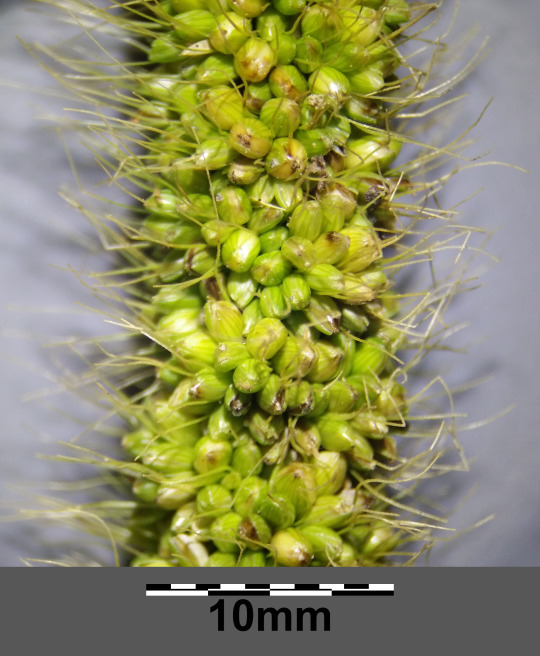
[Other plants mentioned]
Certain other plants are mentioned more incidental in this section.
Plants more or less suited to precede foxtail millet in a crop rotation system:
Mung beans or green gram (Vigna radiata), lüdou緑豆 (lit. "green beans"), used as green manure in crop rotation with millet.

Adzuki beans (Vigna angularis), xiaodou小豆 (lit. "small beans") served a similar function.
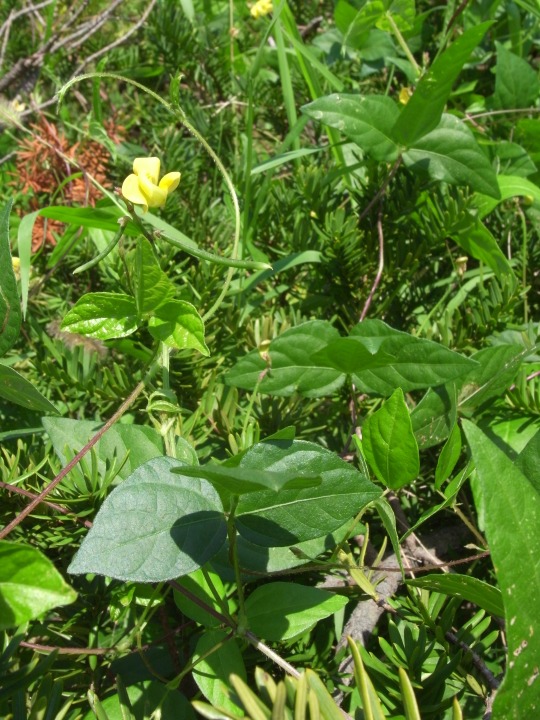
Hemp (Cannabis sativa), ma麻, grown both for textiles and oil

Broomcorn millet (Panicum miliaceum), shu黍, popular for brewing millet beer

Sesame (Sesamum indicum), huma胡麻 (lit. “foreign hemp”), considered the best oilseed crop

Turnip (Brassica rapa var. rapa),wujin蕪菁, leaves and roots are edible, and the seeds can be pressed for oil.

Soybean (Glycine max) dadou大豆 (lit. “large beans”), used as fodder or famine crop, but also fermented into sauces, etc.
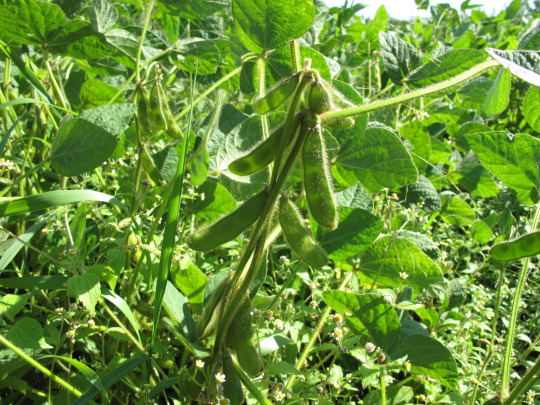
Gua底 is a general term for gourds and melons
Trees whose leaves and flowers can be used to predict the best time for sowing foxtail millet:
Beiyang菩楊 appear to refer to some kind of willow (Salix) or poplar (Populus)

Peach (Prunus persica), tao 桃

Jujube (Ziziphus jujube), zao棗
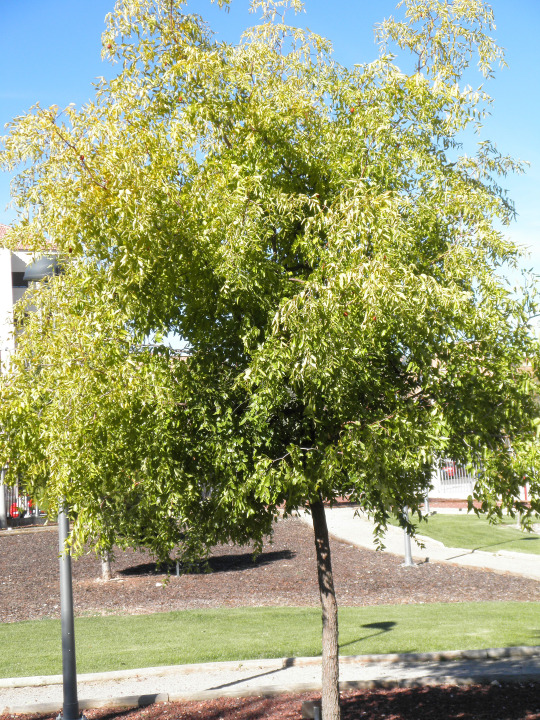
Mulberry (Morus alba), sang桑

[Tools]
The illustrations below are taken from Wang Zhen's王禎 (1271-1333) Nongshu農書, who of course wrote several centuries after Jia Shixie. While many tools were essentially timeless and in continuous use up to the modern age, developments did happen, and also terminology could change.
The preferred tool for sowing was the seed drill, lou耬
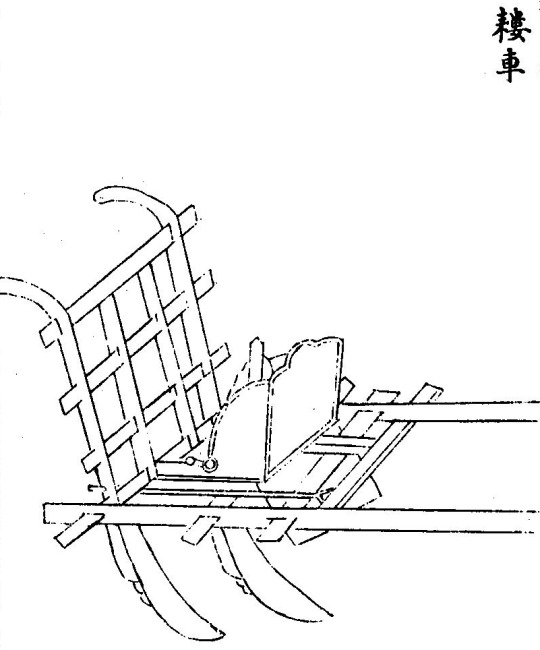
(Wang Zhen's louche耬車).
The “beater”, ta撻, (for a lack of a better translation) was pulled over the furrows after sowing to compact them. Wang Zhen describes this tool as a bunch of branches weighed down by stones.
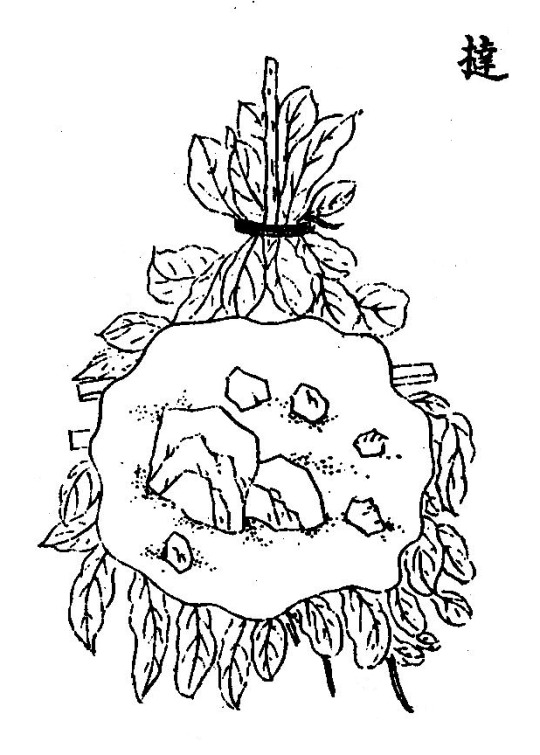
The arrowhead hoe, zuchuo鏃鋤 was a small, pointed hoe. According to Wang Zhen, arrowhead hoeing was one of four methods for hoeing with the youchu耰鋤.
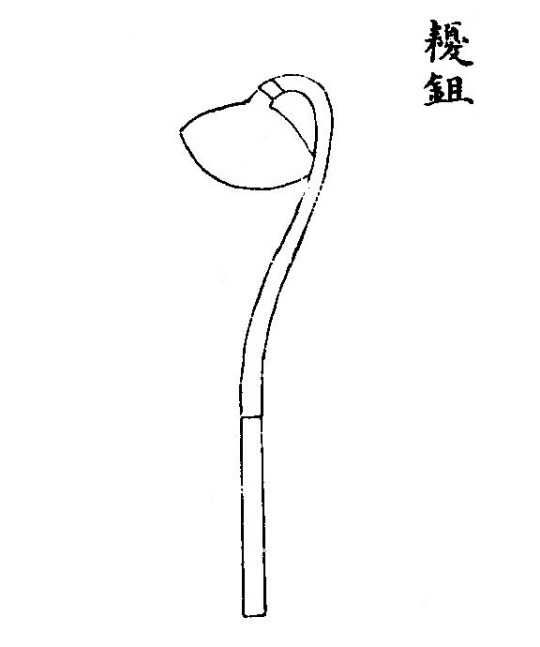
QMYS is the oldest text to refer to the iron-tine rake, tiechi loucou鐵齒𨫒楱
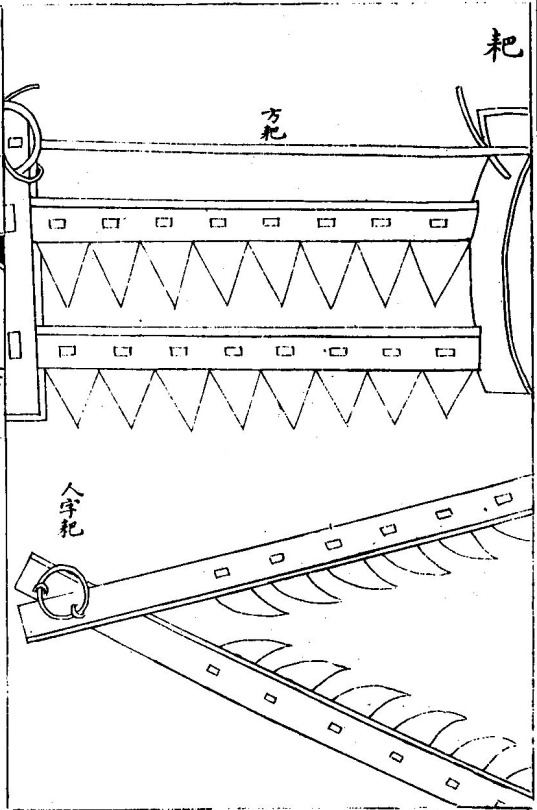
QMYS quite often refer to the spear-harrow, feng鋒. Wang Zhen notes that by his time it was no longer in use, his description of it as a cross between a plough and a spade may therefore not be very accurate.

The sickle, yi刈, was the main tool for reaping field crops.
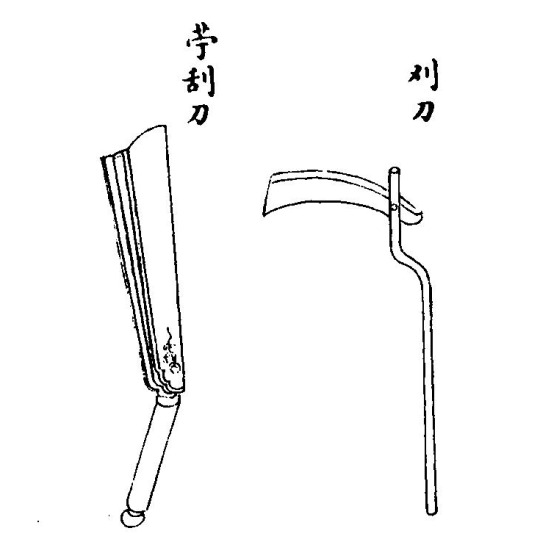
(Wang Zhen's yidao刈刀)
[Books quoted by QMYS in Section 3, in order of appearance]
The Erya爾雅 (“Approaching the Correct”) is the oldest surviving Chinese glossary. Modern scholarship dates the book to the late Warring States and/or early Western Han periods. It is quoted numerous times in QMYS. This is the second QMYS section to quote from the Erya. The last previous was Section 1 (“Tilling the Fields”).
The Shuowen 說文 (“Explaining Graphs”) by Xu Shen許慎 (c. 58 – c. 147) analyses the composition and reasoning behind the different characters. It is quoted numerous times in QMYS. This is the second QMYS section to quote from the Shuowen. The last previous was Section 1 (“Tilling the Fields”).
The Guangzhi廣志 (“Wide Treatise”) by Guo Yigong郭義恭 (Western Jin) is now lost, but it is quoted numerous times in QMYS and other books. This is the first QMYS section to quote from the Guangzhi.
Guo Pu郭璞(276 – 324) was a Daoist wizard, poet and writer. His surviving writings include the oldest extant commentary on the Erya and a commentary on the Shanhaijing. This is the first QMYS section to quote Guo Pu, from his Erya commentary.
Sun Yan孫炎 lived during Wei and was disciple of Zheng Xuan. He wrote (a now lost) commentary on the Erya where he pioneered the use of the fanqie system to indicate pronunciation. This is the first QMYS section to quote Sun Yan.
Liu Zhang 劉章(200 – 176) was a grandson of the Han founder. According to the Shiji he recited the Gengtian ge 耕田歌 (“Song of Ploughing the Fields”)at a banquet during the regency of Empress Dowager Lü, to show his opposition to the Lü clan's power, and he later became one of the main actors in their downfall.
The Guanzi管子 (“Master Guan”) is a collection of treatises on statecraft traditionally attributed to Guan Zhong管子 (d. 645 BC9), an influential minister in Qi during the Spring and Autumn era. Section 3 contains the third quote from the Guanzi in QMYS, the first two are in the preface (which I have impudently skipped).
[The original text is a mix of large and small characters. I have collected the small text sections together as indented notes within {} brackets.]
[Translation starts here]
Section 3, Growing Foxtail millet
Growing foxtail millet [gu穀]:
{“Grain” gu穀 and “foxtail millet” ji稷 are names for setaria millet [su粟]. Grain is the collective name for the Five Grains, and does not mean setaria millet. However, today people solely consider foxtail millet to be “grain”, and [I] look to the customary name for it, and that is all.} [For the remainder, gu穀 will be translated as “foxtail millet” in the sections written by Jia Sixie, ji稷 will generally be rendered also as “foxtail millet”, and su粟 as “setaria millet” (or just “foxtail” and “setaria”).] {The Approaching the Correctsays: “Zi粢 is foxtail millet [ji稷].”} {The Explaining Graphs says: “Setaria millet [su粟] is the fruit of excellent grain [gu穀].”} {Guo Yigong's Broad Treatise says: “The names of the kinds are Red Setaria and White Stem, Black-Patterned Sparrow Setaria, Duke Zhang's Mottled, Enclosed Yellow-Iron-green, Dark-green Foxtail, Snow-White Millet – likewise named White Stem, also White-Indigo Short, Bamboo Head-Stem Dark-green, White Wheat-Catching, Stone-Pulling Purest, Earth-black Dog-Paw.”} {Guo Pu's Annotations to the Approaching the Correct says: “Today in Jiangdong they call foxtail millet zi粢.”} {Sun Yan says: “Foxtail [ji稷] is setaria [su粟]”} {Note that the present age's names for setaria, many uses a person's family and courtesy names as the label name. There are likewise those where look and form established the names, and likewise those where what happened to be appropriate became the designation, [I] rely on them then to set them out, and that is all:} {Vermillion Foxtail, Highland Yellow, Liu Zhuxie, Daomin Yellow, Whittled-Grain Yellow, Sparrow's Regret Yellow, Continued Life Yellow, Hundred Days Grain, Upright Wife Yellow, Unworthy-of-Rice Grain, Slave Child Yellow, Jiazhi Foxtail, Schorced Gold Yellow, Quail's Slipper Iron-green which is also named Wheat's Floor-Fighter: These fourteen types ripen early and endure drought, early ripening avoids insects. The Whittled-Grain Yellow and Unworthy-of-Rice Grain types have a pleasing taste.} {Now-Fell-off-the-Chariot, Short Horse-Carer, Hundred Flock Sheep, Hanging Snake Red-Tail, Bear-Tiger Yellow, Sparrow's and People's Benefit, Horse Reins, Liu Pig Red, Li Yu Yellow, Amba Grain, Donghai Yellow, Rocky lesuo䮑歲, Dark-green-Stalked Dark-green, Dark Excellent Yellow, South-of-the-Paths Crop, Nook-and-Dike Yellow, Song Ji's Idiocy, Point Out Yellow, Rabbit Foot Dark-green, Kind Sun Yellow, Shifting Wind Red, Single Sunlight Yellow, Mountain Saline, Dundang Yellow: These twenty-four types all have spikes with bristles, endure wind, and avoid harassment from sparrows. The Single Sunlight Yellow type is easy to hull.}
{Precious Pearls Yellow, Popular Gain White, Zhang Lin Yellow, White Salt Foxtail, Thousand Hooks Yellow, Zhang Yi Yellow, Gleaming Tiger Yellow, Chief Slave Red, Reed-Stalk Yellow, Xun Pig Red, Wei Shuang Yellow, White-Stalked Dark-green, Bamboo-Rooted Yellow, Attuned Mother Large-grained millet, Rock-Pile Yellow, Liu Sand-White, Seng Long-lasting Yellow, Red Large-grained Foxtail, Auspicous Swift Yellow, Otter-Tail Dark-green, Continued Potency Yellow, Concave-Straw Yellow, Sun Long-lasting Yellow, Pig-Shit Dark-green, Smoking Yellow, Happy Slave-girl Dark-green, Level Long-life Yellow, Deer Stubble White, Salt for Breaking Baskets, Yellow dianshan, Hilly Place Yellow, Red Ba Large-grained millet, Deer Hoof Yellow, Famished Dog Iron-green, Can-be-Pitied Yellow, Hulled Foxtail, Deer Stubble Dark-green, Aluoluo: These thirty-eight types are the single stems great foxtails? [the received QMYS text is defective at this point]. The White Salt Foxtail and Attuned Mother Large-grained millet types have a pleasing taste. The three Concave-Straw Yellow, Hilly Place Yellow and Pig-Shit Dark-green types are bad tasting. The Yellow dianshan and Happy Slave-girl Dark-green types are easy to hull.} {Bamboo-Leaf Dark-green and Rocky Yichu, Bamboo-Leaf Dark-green is also named Hu Foxtail, Water Black Foxtail, Swift Mud Dark-green, Charging Heaven Cudgels, Pheasant Chick Dark-green, Owl-Foot Foxtail, Goose-Head Dark-green, Hold-Piles Yellow, Dark-green Hawk-cuckoo: These ten types ripen late and endure floods. If there is a calamity of insects, they are consumed.}
In general there is foxtail which is fully ripened early or late, which sprouts and straw are tall or low, which harvest results are large or small, which natural quality is strong or weak, which hulled grain taste good or bad, which grain results in gains or losses{A}. The conditions of the land can be good or poor{B}, and mountains and marshes differ in what is suitable{C}. Obey Heaven's seasons, and evaluate the land's advantages, then [you] will employ little strength yet achieve success many times. Rely on feelings and go against the Way, [you] will toil and yet get nothing.{D}
{A: Those that ripen early have short sprouts and the harvest is large. Those that ripen late have long sprouts and the harvest is small. Those which strong sprouts are short, and belong to the yellow foxtail. Those which weak sprouts are long, and are dark-green, white, or black. Those with small harvests are good but make losses. Those with large harvests are bad but make gains.} {B: Good fields are suitable for late types, poor fields are suitable for early types. Good land is not solely suitable for late types, early types are also not harmful. Poor land is suitable for early types, late types will certainly not give successful result.} {C: For mountain fields, types with strong sprouts, to avoid wind and frost. For marsh fields, types with weak sprouts, to aspire to splendid results.} {D: Enter a spring to chop wood and climb a mountain to look for fish, and the hand will surely be empty. To face the wind when sprinkling water, or to go against the slope when moving a pellet, these conditions are difficult.}
In general for foxtail fields, mung beans or adzuki beans as the previous crop is the best; hemp, broomcorn millet, and sesame are next; turnip and soy beans are last.
{It is common to see gourds as the previous crop, they are no less than mung beans. Originally they were not discussed, for the moment then keep it in mind.} [This note may be a later addition.]
For 1 mu of good land, use 5 sheng of seeds, and for poor land 3 sheng.{A} Foxtail fields certainly must be changed annually.{B} Those sown in the 2nd Month or the 3rd Month are the early-planted grain. Those sown in the 4th or 5th Month are the late-planted grain. From 2nd Month, First Ten-day, until the hemp and beiyang willow sprout seeds is the best time. 3rd Month, First Ten-day, until the Pure and Clear [qingming] Period and the peach tree first flower is the middle time. 4th Month, First Ten-day until the jujube leaves sprout and the mulberry flowers fall is the worst time. For those which the yearly Way ought to be late, the beginning of the Fifth Month or Sixth Month are also possible.
{A: This is for early-planted foxtail, for late fields increase the number of plants.} {B: If twice sowing the seeds, the weeds will be many, and the harvest poor.}
In general spring sowing wish to be deep, and ought to be dragged with a heavy “beater”. Summer spring wish to be shallow, and just sprout from itself.
{Spring air is cold, and sprouting is slow. If not dragged with a “beater”, they will set root in hollows, and even if they sprout, they will immediately die. Summer air is hot, and they sprout quickly. [If] dragged with the “beater” and there happens to be rain, [the ground] will surely be hard and dry. Those in the spring that are very moist sometimes also are not necessary to beat. To be certain they want beating, [you] ought necessarily to wait for [the ground] to turn white. Wet beating will cause the ground to be hard and tough is the reason.}
In general when sowing foxtail, after rain is good. If there is a little rain, [you] ought accept the wetness and sow. If there is great rain, wait for the weeds to sprout.{A} During spring, if there is drought, on the land of the autumn tilling [you] might open the mounds and wait for rain.{B} During summer, if there are open mounds, not only will it sweep away and wash out that which does not grow, [but] in addition it and the grassy weeds will set forth together.
{A: [If] there is a little rain and [you] do not accept the wetness, there is nothing to give birth to the stalks sprouting. [If] there is great rain and [you] do not wait for [the ground] to turn white, wet rolling then will cause the sprouts to be frail. If weeds are abundant, to first hoe one time everywhere and afterwards accept sowing then will be good.} {B: On the spring-tilled, it does not hit the mark.}
In general the fields that want early or late are mixed together.{A} In years that are intercalary, after the solar periods draw close, [you] ought to have late fields. However for the most part [you] want early, early fields yield more than late.{B}
{A: Prepare for what is proper in the Way of the year.} {B: Early fields are clean and easy to manage. The late ones overgrow with weeds and are difficult to manage. Their harvest, regardless of large or small, follows from is proper for the year, and is not connected to early or late. However, early foxtail have thin husks, the hulled grains are solid and many. Late foxtail have thick husks, the hulled grain are small and empty.}
When the sprouts have grown similar to horse ears, then arrowhead hoe.{A} At places with gaps and holes, hoe and patch them.{B} In general for the Five Grains, only the small hoe is good.{C} For good fields, usually for each chi [foot], keep one hole.{D} For poor land, seek out mounds and tread on them.{E}
{A: The proverb says: “Want to get foxtail, at horse ears the arrowhead.” } {B: The work done might not be overstated. The profit gained this way is a hundred times.} {C: The small hoe not only saves strength, the grain is also twice as good. With a large hoe, the grass and their roots will be profuse and thick, a lot of work will be done yet the harvest will grow smaller.} {D: Liu Zhang's Song of Tilling the Fields says: “Plough deeply and sow thickly, the standing sprouts want to be spread out. For those not of their kind, hoe and get rid of them. The proverb which states: “[When you can] turn around the chariot and reverse the horse, [or] throw away the clothes [and they] do not fall down, both give ten shi when harvested” tells that harvest for [fields that are] very sparse or very thick are all equal and even.} {E: Not tilling is the reason.}
When the sprouts spring forth from the mounds, hoe deeply. When hoeing, do not get bored with the frequency. Once done, start again. [You] must not stop though there is no grass.{A} Spring hoeing is to lift up the earth, and summer to remove grass. For that reason, spring hoeing is not done when facing wetness. By the 6th Month and after, even if wet, in this case is not disliked.{B}
{A: Hoe not just to remove the grass, then the land will ripen and the fruit will be many, the chaff will be weak, and the hulled grain will grow. When hoeing is done ten times everywhere, [you] will then obtain “Eight [parts of ten?] Hulled grain”.} {B: During spring, as the sprouts are just then slight and their shade are not yet covering the ground, if wet hoeing, the ground will become hard. During summer, the sprouts cast a solid shade and the ground does not see the sun. For that reason, even if wet, in this case there is no harm. Master Guan says: “To make a state, cause the farmers to till when cold and weed [yun芸] when hot.” To weed is to remove grass.}
When the sprouts have sprung from the mounds, each time [you] have gone through rain, in the time [the ground] turns white, immediately use the iron-tine rake across and athwart to rake and harrow them.
{Method for raking: Make a person sit down on top, and frequently use their hands to tear off and get rid of grass, if grass block up the tines it will harm the sprouts. Like this [you] will make the ground ripe and soft, easy to hoe and save strength. When hitting the spear-harrow, stop.}
When the sprouts are one chi high, spear-harrow them.{A} Tillage is not about not embedding the root sprouts deeply, it kills the grass and increase the results, however it will make the ground hard and tough, lacking in moisture and difficult to till. Hoe five times everywhere or more, and it will not be bothersome to till.{B}
{A: Three times everywhere is always good.} {B: When for sure [you] want to till, after you have reaped the foxtail, if you promptly spear-harrow below the roots to burst them up, it will be soft and moist, and easy to till.}
In general when sowing, [you] want the ox to move slow and leisurely. The sower makes hurried steps to tread the mound base with his feet.
{If the ox is slow, the seeds will be evenly placed. If trod with the feet, the sprouts will thrive. When the footsteps connect with each other, it is possible to not bother with beating.}
When ripe, reap quickly. When dry, store quickly.
{If reaped early, the sickle-use will be excessive. If reaped late, the spikes will break. If there is wind, the harvest will diminish. If stored wet, the stalks will rot. If stored late, there is loss and waste. If continuous rain, they will grow ears.}
In general for the Five Grains, for the most part those sown in the first ten-day will give a full harvest, those in the middle ten-day a middle harvest, and those in the last ten-day a lesser harvest.
7 notes
·
View notes
Text
Clean Beauty For A Natural Look!

Clean beauty has become a popular term not just in the USA but around the world. Going far beyond a trend, it has become a movement that has united so many people who demand safer and better products. This demand for sustainable and cruelty-free products is at an all-time high, with more people prioritizing their health and the planet.
Frequent shoppers like yourselves increasingly seek transparency from their favorite brands. They want to know where ingredients come from, how products are made, and what impact they have on the planet. This growing awareness has pushed brands like ours to innovate and offer products that are not only effective but also safe and ethical. This shift isn’t just in beauty and selfcare, it's a universal shift towards sustainability and health.
How Dr. Natural Keeps Its Clean Beauty Promise
At Dr. Natural, we take our clean beauty promise seriously. As a selfcare brand, we are always putting YOU first! Your skin’s health is our first priority, followed by supporting sustainability for building a better world together. Our commitment to pure ingredients, safe formulations, and cruelty-free practices sets us apart in the selfcare industry. We believe that what you put on your skin should be as natural and pure as what you put into your body. That's why our products nourish and protect your skin without exposing it to harmful chemicals.
Natural Ingredients:
Our products are formulated with high-quality natural ingredients like shea butter, coconut oil, olive oil, and hemp. These ingredients are known for their moisturizing, soothing, and healing properties, making them ideal for maintaining healthy, radiant skin.
Chemical-Free:
We do not use synthetic fragrances, parabens, sulfates, and other harsh chemicals that can irritate the skin and disrupt its function. Our chemical-free products ensure that your skincare routine is safe and gentle, even for the most sensitive skin types.
Cruelty-Free:
We are proud to be a cruelty-free brand. None of our products are tested on animals, and we ensure that our suppliers adhere to the same ethical standards. By choosing Dr. Natural, you are supporting a brand that respects our furry friends
Dr. Natural products are effective and incredibly hydrating to cleanse and preserve skin’s health with nature’s goodness. If you're new to Dr. Natural or looking to expand your collection, here are some of our bestselling products that embody our clean beauty ethos:
Pure Liquid Castile Soap: A versatile and gentle cleanser made with natural essential oils like coconut and shea butter. It's perfect for everyday use, leaving your skin feeling clean, soft, and hydrated. Whether you use it as a body wash, hand soap, or even a shampoo, you'll love its refreshing and non-toxic formula.
Black Soap: Known for its deep cleansing properties, our liquid body soap is made with hydrating plant-based ingredients and is an excellent choice for those with oily or acne-prone skin, as it helps to clear up blemishes and balance oil production.
Hemp Body Wash: Infused with hemp seed oil, it is the best natural body wash for your sensitive skin. It soothes and moisturizes your skin with a gentle touch. Hemp seed oil is known for its anti-inflammatory and antioxidant properties, making it a great addition to your skincare routine for maintaining healthy and youthful skin.
Achieve natural radiance without compromising on your values. So why not make the switch today and experience the benefits of clean beauty for yourself?
#pure liquid castile soap#best natural body wash#liquid body wash#dr. natural#natural bath and body products
2 notes
·
View notes
Text
Character Intro: Damia (Kingdom of Ichor)

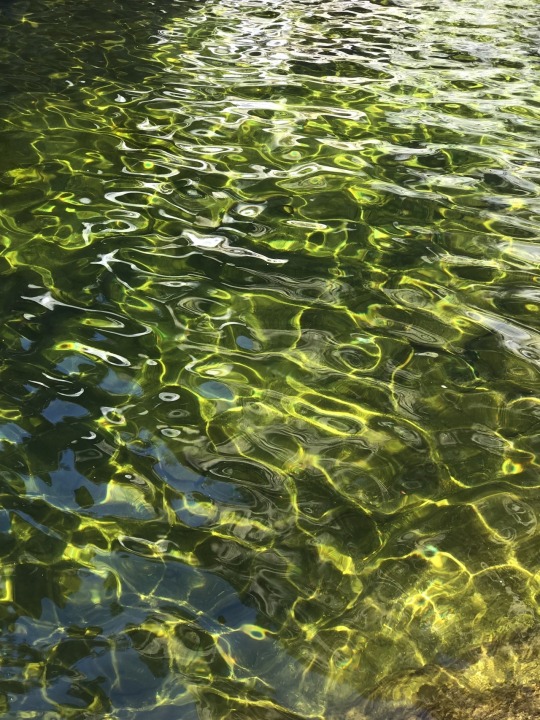
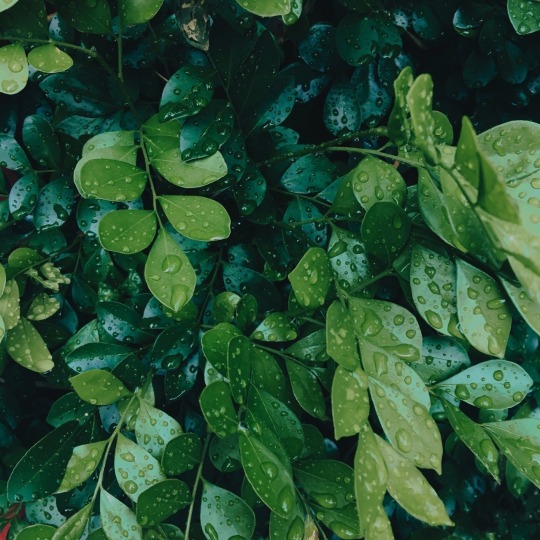


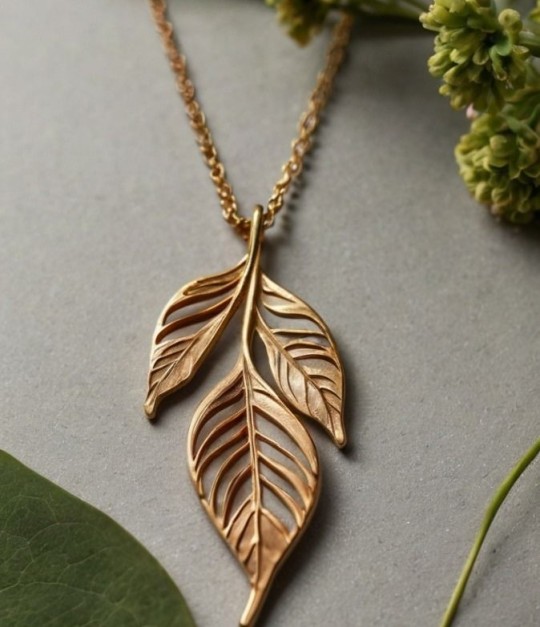
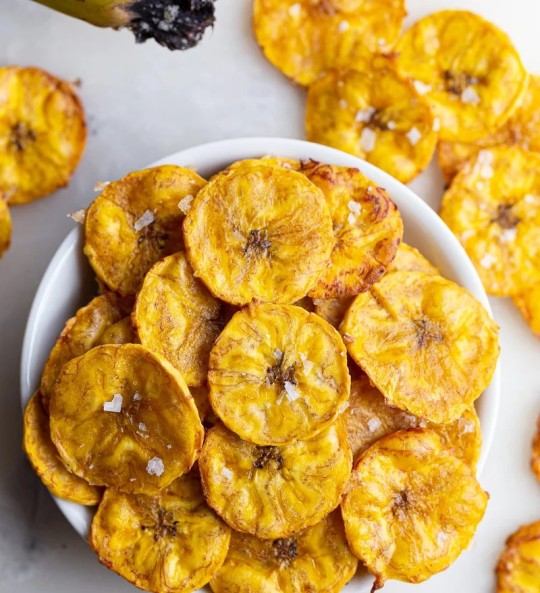
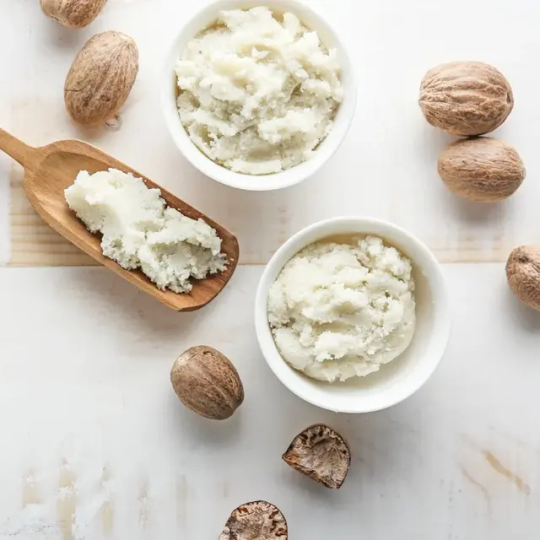
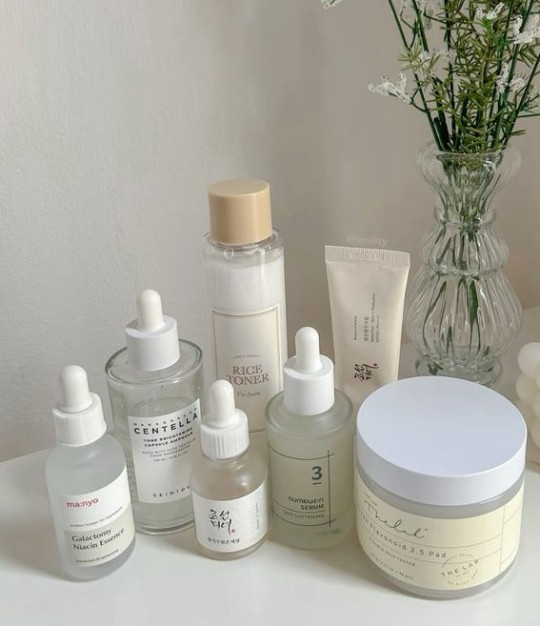
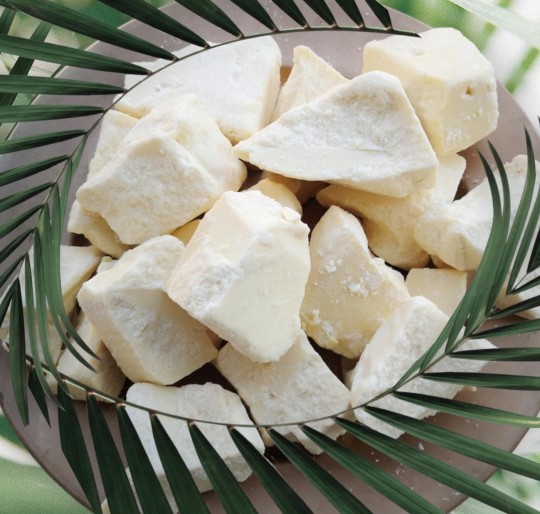
Nicknames- Ms. Bare by some of the male deities in the pantheon
The Ambrosia Goddess by the people of Olympius
Dewy by Pan
Age- 43 (immortal)
Location- Hearthwood neighborhood, New Olympus
Personality- She's an endearing naturalist- wholeheartedly attached to the outside world with a deep love & respect for nature. She enjoys her time outdoors, either by herself or with company. She's also serene, earthy, and observant. She's pansexual & is polyamorous.
She has the standard abilities of a goddess except shapeshifting. As the goddess of naturalness her other powers/abilities include ambrosia generation/manipulation, photokinesis, absolute restoration (restoring something back to its natural state), purification, energy matter manipulation, dew generation/manipulation, vitakinesis (healing), limited ecokinesis (nature manipulation), feromonikinesis (pheromone manipulation), limited cosmetic manipulation, and feromonigenesis (pheromone generation).
Damia splits her time between New Olympus & the state of Arcadia.
Her primary abode is her cottage in the Hearthwood neighborhood of New Olympus. The interior design is naturalistic with wood flooring, bamboo shades on the windows, stone countertops & wood cabinets in the kitchen, various woodland plants and flowers hanging from the ceiling, cotton, linen, & vegan leather furniture, as well as jute, wicker, and rattan furniture pieces. The color scheme is sage, cream, brown, forest green, & beige. In the backyard there's a small stone-lined freshwater pool, a garden, a compost pile, and a small greenhouse.
Damia has a plethora of pets! Birds such as cockatiels, canaries, lovebirds, parakeets, & greenfinches. There's also a tabby cat named Moss and two yorkshire terriers named Oat & Barley.
She primarily gets around by riding her bike, walking, and public transportation.
In Arcadia, Damia will stay at the commune of her friend/lover Pan (god of the wild, satyrs, shepherds, & rustic music).
She'll usually start off her mornings with an at-home session with her acupuncturist followed by an extended class of hatha yoga at the Zenesphere yoga studio.
She's fluent in Old Greek and Minoan.
When Damia bathes, she likes using her own vegan cruelty-free soap bars. Her personal favorite scents are the bergamot-mandarin & the clover-aloe. If Damia's not going anywhere or is planning to stay at home for a while, she can go a few days without bathing or showering.
While wearing clothes, more often than not, she doesn't wear undergarments- like a bra & panties. At home and when she's sleeping, she's nude.
Damia is a disciplined vegan. She doesn't eat food or use products derived from animals. All her clothes are vegan too, bought from ethical vegan fashion brands. Staples of vegan clothing include the use of fabrics like hemp, cotton, bamboo, soya-bean fiber, & banana wool. This also includes faux leather as well as ethical and sustainable jewelry. She's also a dedicated recycler!
A typical breakfast for her is a big bowl of Earthly Harvest rice cereal with coconut milk. She also enjoys the Golly Grains fruit medley cereal, roasted corn avocado toast, sweet sesame tahini oatmeal (topped with sliced apricot, toasted pistachios, & pomegranate seeds), chia pudding, and oat flour pancakes (topped with sliced bananas & organic coconut syrup). She's also a fan of the vegan breakfast burrito from The Bread Box (added with scrambled tofu, mushrooms, roasted sweet potatoes, and creamy tahini sauce).
She's a fan of wearing body jewelry!
A notable physical feature of Damia are her long dark brown dreadlocks. She likes decorating them with shells, hair cuffs, hair wires, & hair jewelry. She swears by the Hairology soap free shea butter shampoo bar, the Olmorfia clarifying detox shampoo, as well as the Glory's Crown castor oil deep conditioner and healthy hair oil blend.
Her fashion style is totally bohemian. Staples in her closet include oversized sunglasses, shawls, ties, & headbands, eclectic prints, flowy maxi skirts and dresses, halter tops, peasant blouses, tube tops, as well as quirkly embellishments. Damia's favorite fashion brand that focuses on the bohemian style (and is also ethical & vegan) is Olive + Willow, started by a dryad fashion designer named Wren Evergreen who she's also friends with!
A go-to drink for her is a lychee martini. She also likes mineral water, aloe vera juice, coconut milk, orange juice, coconut water, lychee juice, sparkling mint infused water, ginger ale, pomegranate juice, gin martinis, good farmer cocktails, peartinis, shirley temples, her homemade spiced strawberry-goji berry smoothies, botanical beer, cashew milk, & honeydew martinis. Usuals from The Roasted Bean includes a small chestnut praline almondmilk latte, a large iced green tea, and an olympian sized grapefruit-ginger splash.
Damia makes her own plant based vegan butter.
In the pantheon, she's known for her tasty homemade granola.
The superfood salad along with a small spinach soup is her go-to order at The Bread Box.
Damia typically doesn't wear makeup. She firmly believes that makeup should accentuate one's beauty, not cover it. When she's in the mood to wear cosmetics, Damia is a fan of the makeup brand Apothecary, created by Hygieia (goddess of hygiene & cleanliness). Her go-to products to use are the illuminating super gel lightweight dewy highlighter, the hydro grip hydrating makeup primer, the talc-free brightening blush in the shade "Blessed", the shine on non-sticky lip gloss in the shade "Almond", the super skin tint sunscreen foundation in the shade "Caramel Sugar" (a medium shade with golden olive undertones), and the non-toxic cruelty free nail polish color "Sugar Cookie," a sheer cream shade.
She loves snacking on air fried plantain chips.
Damia had a full frontal spread in the men's magazine owned by Zeus (god of the sky, thunder, & lightning). A lot of beings considered it daring when her thick unshaved pubic hair was shown in the nude shoots. She doesn't understand the discord her photos started up on Fatestagram.
She has quite the book collection on botany and anthropology.
Her primary means of income comes from teaching environmental science at New Olympus University. She also writes for the beauty section in Vital Essence magazine. With her own personal endeavors, Damia owns a small all-natural shop in the Hearthwood neighborhood called Oasis. Products sold there include protein powders, nutritional supplements, artisinal body products (like raw cocoa & shea butter), and even healing crystals. The store has its own official website.
A guilty pleasure for her are vegan spring rolls with peanut dipping sauce. She gets them at Garden Gatherings, a vegan restaurant owned by Pasithea (goddess of hallucinations & relaxation).
Damia's best friend in the entire pantheon is Nymphe (goddess of self-care). They call, text, & hang out with each other all the time. She's also good friends with Nárkosi (goddess of sedation), Demeter (goddess of the harvest & agriculture), Ichnaea (goddess of tracking), Spermo (goddess of grains), Kópros (god of manure & excrement), Hesychia (goddess of quiet, stillness, rest, & silence), Aegle (goddess of good health), Pherusa (goddess of substance & farm estates), Epione (goddess of soothing pain), Thilasmós (goddess of nursing), Elais (goddess of oil), Apheleia (goddess of simplicity), The Ourea (esteemed mountain gods), Corymbus (Cory) (god of the ivy), Anatole (goddess of sunrise), Gymnasia (goddess of excercise & gymnastics), Elpis (goddess of hope), Sponde (goddess of libations), Philotes (goddess of sex, friendship, & affection), Sardo (one of The Nesoi), Hestia (goddess of the hearth), and Priapus (god of fertility, vegetable gardens, livestock, sexuality, & masculinity).
She greatly admires Gaia (goddess of the earth). She met the great goddess herself when she was invited to her estate in Meteora. Damia was more than happy when she was allowed to ride Gaia's dragon Gwyndern.
Her favorite frozen treat is dragonfruit sorbet.
Damia is a lover of Philotes and Priapus. Her current main lover is a lotus eater named Ambrose. They have had four ways a few times.
Her first lover was Cyamites (god of beans).
She can play the acoustic guitar, ukulele, mandolin, & conga drum.
A brand new business venture she's stepping into is a raw vegan restaurant called akatérgastos- scheduled to open up in the Queenstown neighborhood. The restuarant is currently in construction. The hopeful appeal is that everything served in the restaurant is vegan, non-dairy, and gluten free- with nothing being cooked over 120 degrees. Pan, Nymphe, & Priapus were financial backers. If the grand opening is a success, Damia plans for two more locations- in Arcadia and the Hearthwood neighborhood.
Her favorite dessert are the mini fruit medly tarts from Hollyhock's Bakery.
She once spent a long weekend at The Lytêrios Oasis (a nudist resort) with Nymphe, Sardo, Hesychia, and Philotes.
In her free time Damia enjoys gardening, sunbathing, reading, swimming, football (soccer), surfing, volleyball, going to flea markets, cloud surfing, meal prepping, hiking, mountain climbing, going to the spa, horseback riding, photography, sailing, bird watching, & making love.
Her favorite meal is spicy kale with coconut fried rice.
"Being natural isn't a statement. It's the closest thing you can get to being yourself."
#my oc#my character#oc character#my oc character#oc intro#character intro#oc introduction#character introduction#modern greek gods#modern greek mythology#greek myth retellings#greek goddess#greek goddesses#greek mythology#greek pantheon#greek myths
2 notes
·
View notes
Text
Breakfast: Black coffee with cinnamon - 5 cal
Lunch: Latte with regular milk (I rarely use regular coffee but I was at work and I didn't had my plant milk) - 86 cal
Snack: 100g plant bases coconut yogurt (78 cal), 100g blueberries (57 cal), 10g hemp seeds (59 cal) - 194 cal
Dinner - 1 medium tomato (22 cal), 210g eggplant (50 cal), 7ml olive oil (67 cal), slice of bread (96 cal), some seasoning (1 cal) - 231 cal
Total - 511 calories
Doesn't seems like a lot but somehow I dont believe its only 511 calories idk the apps r lying
2 notes
·
View notes
Note
First of all, I've absolutely loved the fic, I love how you write them interacting with eachother. Secondly, I'd love to hear more about your lube research because from what I've gathered Vaseline was invented in 1872, but it became a popular lubricant in the mid 1900's and the first comercial lube was invented in 1904.
Thanks for your fic!
I full body CACKLED at this ask 🤣 thank you for liking my fic! It means the world to me that people are liking it!
As for the research…
I am no historian by ANY means, so I just waved my hand around some technical things and made up a rhetoric for myself:
If one person from this couple is a more seasoned veteran on being gay, he���d know more about **things**
Said person is not rich (by the era standards) but he’s probably got good connections in a community that is marginalized and persecuted (meaning, they’ve got each other’s backs and would help out with almost anything, to their abilities)
Probably has had more than 1 partner in the past so it’s trial and error, practice makes perfect, and experience mixed all together
Taking all of this into consideration… while yes, petroleum jelly was **just** invented but hadn’t actually gained a popular status in the market, what were other historically known substances used prior to its invention?
Oils.
And Henry could probably get his hands on some better quality ones (both by his presence as a photographer and how alluring people used to find that profession [ie. payment through services or favors/products for **explicit** photography]). So think, more than the cooking olive oil or oils you’d find in a kitchen, he’d probably have access to things like clove oil or even hemp seed oil. Maybe even GOOD quality ones that come from outside England (importing them would’ve made them wayyy more expensive, but if poppy sold for cheaper than bread, surely some seller would sell nice oils for a more affordable price).
… or they could’ve easily raw-dogged it and used saliva.
#all this to say#in the throes of passion who knows what they might’ve done#you know what other type of research I did?#preservatives.#yes I did look up the history of c*ondoms#I have sooo much respect for s*x historians haha#bodies netflix#ask in the box#alex talks
8 notes
·
View notes
Text
What Is Hemp?
It’s A Trillion Dollar Cash Crop.
youtube
Hemp is a name given to a strain of the cannabis plant.
Hemp is a name given to cultivars of the cannabis plant (Cannabis sativa) that have been selected over many generations for fiber and seed production. Most hemp cultivars contain less than 1.5% THC, a narcotic compound that has the potential for abuse in high concentrations. Cannabis sativa cultivars selected and developed for their drug properties, referred to as marijuana, or dagga, can have a THC content of 3%-25%. Hemp is a bast fiber, producing its fibers in the stalk similar to flax, kenaf, and sun hemp.
Multiple Uses
Hemp fiber and seed are used to produce a wide range of commodities including food and beverage products, fiberboard, insulation, paper, composites, textiles, carpets, animal bedding and feed, cosmetics, body-care products, soaps, paints, fuels, and medicines.
Hemp Seed Food and Beverage Products
Hemp seed contains about 25% protein, 30% carbohydrates, & 15% insoluble fiber. Hemp seed is reported to contain more easily digestible protein than soybeans. Hemp seed contains all 8 amino acids essential to human nutrition. Hemp seed is high in calcium, magnesium, phosphorus, potassium, carotene, sulfur, iron and zinc, as well as Vitamins A, E, C, B1, B2, B3, and B6.
Hemp seed imported into the United States or Canada must be steam sterilized at between 180 degrees F and 212 degrees F for 15 minutes to prevent sprouting. Many US facilities receive imported viable seed under customs bond, steam it, and release it to the consignee or customer with a Certificate of Sterilization.
Hemp food and beverage products include hemp oil and seed, flour, pasta, cheese, tofu, salad dressings, snacks, sweets, hemp protein powders, soft drinks, beer, and wine. Hemp beer can be made from the seed, flowers, sprouts, and seed cake that is a by-product of oil pressing. Hemp beer is produced and sold in Europe and the United States of America.
Hemp Oil
Hemp seed is 25% to 35% oil, and is one of the oils lowest in saturated fats (8%). Hemp seed oil is the richest source of polyunsaturated essential fatty acids (80%). Hemp seed oil is the only common edible seed oil containing Omega-6 Gamma-Linolenic Acid. Hemp seed oil is very fragile and not suitable for cooking.
Pressed hemp seed oil must be bottled immediately under oxygen-free conditions, and must be refrigerated in dark, airtight containers.
Fiberboard
Hemp fiberboard tested by Washington State University Wood Materials and Engineering Laboratory proved to be two and one half times stronger than wood MDF composites, and the hemp composite boards were three times more elastic.
Hemp herds can be used in existing mills without major changes in equipment. Russia, Poland and other Eastern European countries already manufacture composite boards from hemp and other plant materials.
Pulp and Paper
The major use of hemp fiber in Europe is in the production of specialty papers such as cigarette paper, archival paper, tea bags, and currency paper. The average bast fiber pulp and paper mill produces 5,000 tons of paper per year. Most mills process long bast fiber strands, which arrive as bales of cleaned ribbon from per-processing plants located near the cultivation areas.
Composites
Until the 1930’s, hemp-based cellophane, celluloid and other products were common, and Henry Ford used hemp to make car doors and fenders. Today hemp herds can be used to make new plastic and injection-molded products or blended into recycled plastic products. Hemp fibers are introduced into plastics to make them stiffer, stronger and more impact resistant. Hemp plastics can be designed that are hard, dense, and heat resistant, and which can be drilled, ground, milled, and planed.
Hemp plastic products currently made include chairs, boxes, percussion instruments, lampshades, bowls, cups, spectacles, jewelry, skateboards, and snowboards.
Hemp Animal Care
Hemp horse bedding and cat litter are produced and sold in Europe. After oil is extracted from the hemp seed, the remaining seed cake is about 25% protein and makes an excellent feed for chicken, cattle, and fish. Chickens fed hemp seed on a regular basis have been found to produce more eggs, without the added hormones used in most poultry plants.
Fuels
Hemp seed oil can be combined with 15% methanol to create a substitute for diesel fuel which burns 70% cleaner than petroleum diesel. Hemp stalks are rich in fiber and cellulose, making them conducive for conversion into ethanol and methanol fuels that have a higher octane than gasoline and produce less carbon monoxide. These biomass fuels are also free from sulfur, and do not require the addition of lead and benzene used to boost octane and improve engine performance in fossil fuels. Ethanol holds condensation, eliminating oxidation and corrosion, and is reported to reduce carbon dioxide emissions by more than 30%.
Hemp has been studied in Ireland as a biomass fuel to generate electricity. Hemp has been reported to yield 1000 gallons of methanol per acre year. Hemp stalk can be converted to a charcoal-like fuel through a thermochemical process called pyrolysis. Henry Ford operated a biomass pyrolitic plant at Iron Mountain, Michigan in the mid-20th.
Paints and Varnishes and Binders
Until the 1930's, most paints were made from hemp seed oil and flax seed oil. Hemp oil makes a durable, long lasting paint that renders wood water-resistant. Hemp herds have the potential to make glues for composite construction products that are non-toxic and superior to binders currently used. With this technology, industry can produce composite products where all components are derived from hemp.
Markets for Hemp Pulp
Some paper manufacturers already have the equipment to process decorticated hemp fiber into paper. The leading European supplier of non-wood pulp, Celesa, currently produces about 10,000 tons per year of pulp from hemp. The use of hemp pulp in blends with recycled fiber of other non-wood fibers is growing. Tests by several European pulp and paper producers suggest that hemp pulp may replace cotton cost effectively in several specialty paper applications.
Potential Markets for Medical Application of Low-THC Hemp Cultivars
Many cannabis medicines have been produced using cannabis cultivars high in THC, and there has been medical research into cannabis that is low in THC and high in CBD. CBD is a cannabinoid that does not have many of the psychoactive effects associated with THC. CBD has been used to treat the following medical conditions: epilepsy, dystonic movement disorders, inflammatory disorders, pain, chronic insomnia, chorea, cerebral palsy, and Tourette's syndrome. According to a July 1998 report by the National Institute of Health, CBD may hold promise for preventing brain damage in strokes, Alzheimer’s disease, Parkinson’s disease and even heart attacks and has been found to prevent brain cell death in an experimental stroke model.
Please share this with your friends.
youtube
#hemp farming#hemp foods#hemp fuel#industrial hemp#hemp plastic#hemp paper#hemp fibers#hemp seeds#hemp prohibition
4 notes
·
View notes
Text
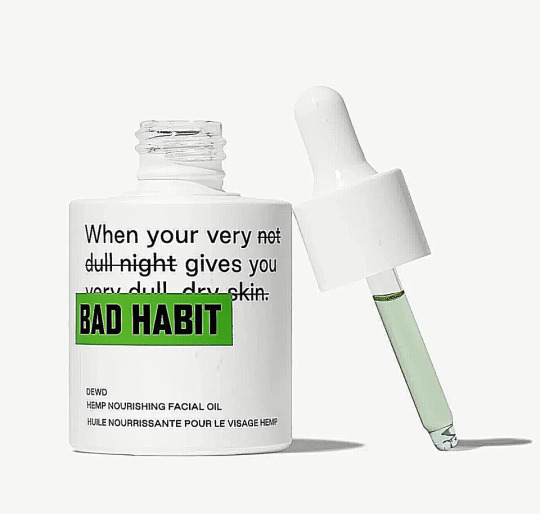


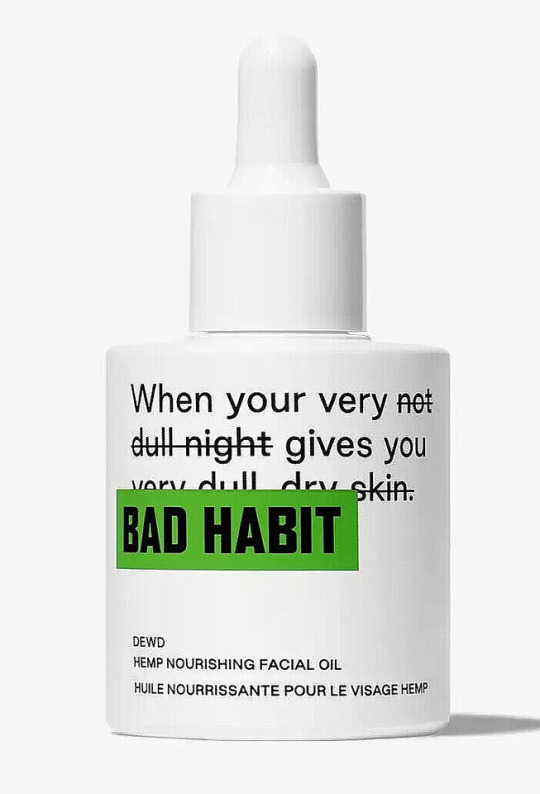


BAD HABIT DEWD HEMP NOURISHING FACIAL OIL 1 OZ MORINGA SATIVA ADAPTOGEN LAVENDER.
This deeply moisturizing oil is infused with ultra-nourishing botanicals for dewy, healthy-looking skin.
Nourishing hemp and moringa seed oil deeply moisturize
Adaptogens help relieve stressed-out skin
Lavender and geranium essential oils soothe your senses*
Deeply moisturize skin with this lightweight, fast-absorbing elixir. Powered by hemp seed oil, this non-greasy formula provides an optimal balance of omega fatty acids to visibly calm, brighten, and nourish stressed-out and irritated skin. Antioxidant-rich moringa seed oil deeply moisturizes to get skin glowing, and a blend of adaptogens—turmeric, licorice, and holy basil—help skin bounce back from environmental stressors. Lavender and geranium essential oils soothe your senses for the ultimate stress relief. Net Weight: 30 mL / 1 fl. oz.
FREE SHIPPING. VOLUME PRICING. THANK YOU!
Results (FROM THEIR WEBSITE):• 100% showed improvement both immediately and 8 hours after application.†• 100% said their skin looked healthy after using the product.†• 97% said the product absorbed quickly after applying.†† Based on a U.S. consumer perception study of 30 participants 8 hours after application.Diheptyl Succinate, Cannabis Sativa Seed Oil, Helianthus Annuus (Sunflower) Seed Oil, Simmondsia Chinensis (Jojoba) Seed Oil, Squalane, Capryloyl Glycerin/Sebacic Acid Copolymer, Carthamus Tinctorius (Safflower) Seed Oil, Melia Azadirachta Leaf Extract, Melia Azadirachta Flower Extract, Corallina Officinalis Extract, Curcuma Longa (Turmeric) Root Extract, Glycyrrhiza Glabra (Licorice) Root Extract, Coccinia Indica Fruit Extract, Solanum Melongena (Eggplant) Fruit Extract, Curcuma Longa (Turmeric) Leaf Extract, Ocimum Sanctum Leaf Extract, Moringa Oleifera Seed Oil, Tocopheryl Acetate, Caprylyl Glycol, Amber Powder, Fragrance (Parfum), Geraniol, Linalool.*Our functional fragrance contains a blend of natural fragrances and essential oils that includes lavender and geranium. #dawnettsemporium, #beautifulmermaidqueen, #shaunalynnsfood.
2 notes
·
View notes